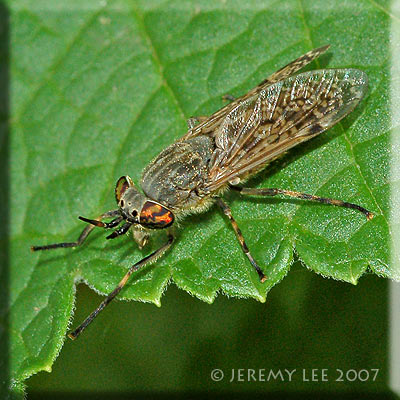
 |
|
Scientific Classifications explained » Amphibians » Ants » Aphids » Bees » Beetles » Birds » Bugs » Butterflies » Caterpillars » Damselflies » Dragonflies » Earwigs » Flies » Frog/Leafhoppers » Fungi » Galls » Grasshoppers » Harvestmen » Hoverflies » Lacewings » Ladybirds » Leaf Mines » Lichens » Mammals » Millipedes » Mosses » Moths » Sawflies » Slugs » Snails » Spiders » Trees & Shrubs » Wasps » Wild Flowers » Woodlice » Postboxes |
UK Nature > Flies > Haematopota pluvialis

Scientific Name: Haematopota pluvialis Common Name: Notch-horned Cleg Fly Haematopota pluvialis is more commonly known as the Notch-horned Cleg Fly or Horse Fly; adults feed on nectar and sometimes pollen. Females usually also feed on blood which aids in egg development. Males lack the necessary mouth parts for blood feeding. Most horse flies feed on mammal blood, but some species are known to feed on birds, amphibians or reptiles. The females' primary sense for locating prey is sight, and they have large compound eyes that serve this purpose well. Horse flies are most active in hot weather, mostly in summer and autumn during the daylight hours. Most species also prefer a wet environment, which makes it easier for them to breed. Eggs are generally laid on stones close to water or on plant stems or leaves. On hatching, the larvae fall into water or moist earth, feeding voraciously on invertebrates, such as snails and earthworms, and small vertebrates. |
|

https://www.uknature.co.uk is a website dedicated to showing the immense diversity of UK nature and wildlife. Our vast range of habitats, from lowland arable to snow covered mountains, from storm-ravaged coastlines to peaceful inland freshwater lakes and rivers, from dry, sandy heaths to deciduous and coniferous forests, all these habitats contribute to the abundance of UK nature. We have wild birds in huge numbers either residing or visiting our shores (597 recorded species as at July 2013) and we must also not forget the humble back garden with its grass lawns, flower beds filled with nectar rich flowers, shrubs and trees, all designed to attract huge numbers of insects such as bees, moths, butterflies and hoverflies; and finally the small ponds which provide safe havens for frogs, toads, newts and even slow worms and grass snakes. www.uknature.co.uk is the showcase for my personal passion, photographing uknature in all its glory. I sincerely hope you all enjoy the fruits of my labours. This site and all images contained therein is © Jeremy Lee 2004 - 2025. All Rights Reserved. Site design by Jeremy Lee. Site development & IT Support by Stuart Lee. |